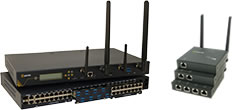
Smart building systems attain 5G speed in 2022 and beyond
By Max BurkhalterJanuary 31, 2022
The idea of the smart home has become a major symbol of the internet of things (IoT). People are using popular devices such as smart thermometers and automated lighting systems to control their homes digitally, collecting and transmitting useful data. But what about larger structures?
Commercial smart buildings represent the other side of the smart home coin. From offices and stores to public gathering places, there are plenty of applications for large-scale installation of IoT sensors and connected systems.
Managers of buildings have an array of options at their disposal as 2022 gets underway, with technology areas such as 5G connectivity adding new power to IoT solutions in general. Operators who have been biding their time on IoT adoption may find this is the perfect time to get involved.
Smart buildings in the 5G era
The most recent market report from The Business Research Company named 5G deployment as the defining trend facing nonresidential building IoT at the moment. Researchers highlighted the ability of 5G connectivity to create rich data sharing between devices. This will help organizations use more IoT components, while also presenting more sophisticated multimedia broadcasts.
The researchers added that with 5G transmission capabilities, building owners can enhance their security technologies. Connectivity around visitor management is a powerful potential use case for buildings such as schools and hospitals that carefully monitor the comings and goings of guests.
The Business Research Company report concluded that the use of smart building systems in nonresidential structures should expand at a compound annual growth rate of 6.7% between 2021 and 2026. By the end of that period, the space would be worth $69.45 billion worldwide.
The 2021 to 2022 CAGR prediction is 8%. The researchers specified that this especially steep increase is due to businesses getting back into action after their activities were heavily restricted by the COVID-19 pandemic in 2020 and 2021.
IoT: A boon to commercial real estate?
A Deloitte report on smart buildings noted one area where advanced digital features could have an immediate positive impact: in the relationship between building owners and their tenants. Structures equipped with IoT devices can provide a more optimized day-to-day experience with tenants. This, in turn, can enhance property value.
The Deloitte study authors noted that large-scale deployments of smart building systems will likely have a larger impact overall than individuals installing smart home systems. After all, a single building management system in a large commercial development can affect the experience of countless tenants, from retail storefronts to apartments.
With smart sensors transmitting data about building usage patterns, building owners can strike up service-based relationships with both their commercial tenants and the end customers who are patronizing the businesses.
What does it look like when building operators use IoT systems to communicate with customers? According to Deloitte, Simon Property Group has already begun using proximity monitoring IoT sensors in its malls. These systems interact with a consumer app that can push marketing messages to shoppers, assist them with navigation and act as a quick payment system.
While smart features in commercial buildings go beyond the standard smart home features such as temperature and lighting adjustment, those features shouldn't be completely forgotten. After all, more efficient adjustment of climate and power use is especially impactful when applied to a large space.
Powerful tech tools needed
How will commercial property owners secure the bandwidth to implement 5G connectivity and other essential components of smart building and IoT systems? The process begins with strong IT infrastructure components, from serial terminal servers to media converters and beyond.
Read Perle's industrial case studies for more information and inspiration, or contact Perle directly.



